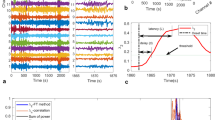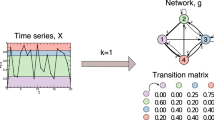Abstract
Networks are naturally occurring phenomena that are studied across many disciplines. The topological features of a network can provide insight into the dynamics of a system as it evolves, and can be used to predict changes in state. The brain is a complex network whose temporal and spatial behavior can be measured using electroencephalography (EEG). This data can be reconstructed to form a family of graphs that represent the state of the brain over time, and the evolution of these graphs can be used to predict changes in brain states, such as the transition from preictal to ictal in patients with epilepsy. This research proposes objective indications of seizure onset observed from minimally invasive scalp EEG. The approach considers the brain as a complex nonlinear dynamical system whose state can be derived through time-delay embedding of the EEG data and characterized to determine change in brain dynamics related to the preictal state. This method targets phase-space graph spectra as biomarkers for seizure prediction, correlates historical degrees of change in spectra, and makes accurate prediction of seizure onset. A significant trend of normalized dissimilarity over time indicates a departure from the norm, and thus a change in state. Our methods show high sensitivity (90–100%) and specificity (90%) on 241 h of scalp EEG training data, and sensitivity and specificity of 70%–90% on test data. Moreover, the algorithm was capable of processing 12.7 min of data per second on an Intel Core i3 CPU in Matlab, showing that real-time analysis is viable.






Similar content being viewed by others
References
Acharya, U.R., Sree, S.V., Ang, P.C.A., Yanti, R., Suri, J.S. (2012). Application of non-linear and wavelet based features for the automated identification of epileptic EEG signals. International Journal of Neural Systems, 22(2), 1250,002.
Andrzejak, R.G., Lehnertz, K., Mormann, F., Rieke, C., David, P., Elger, C.E. (2001). Indications of nonlinear deterministic and finite-dimensional structures in time series of brain electrical activity: dependence on recording region and brain state. Physical Review E, 64(6), 061,907.
Ashbee, W.S., Hively, L., McDonald, J. (2014). Nonlinear epilepsy forewarning by support vector machines. In Epilepsy topics: InTech.
Badawy, R., Macdonell, R., Jackson, G., Berkovic, S. (2009). The peri-ictal state: cortical excitability changes within 24 h of a seizure. Brain, 132(4), 1013–1021.
Bandarabadi, M., Teixeira, C.A., Rasekhi, J., Dourado, A. (2015). Epileptic seizure prediction using relative spectral power features. Clinical Neurophysiology, 126(2), 237–248.
Barriga-Paulino, C.I., Flores, A.B., Gómez, C.M. (2011). Developmental changes in the eeg rhythms of children and young adults. Journal of Psychophysiology, 25(3), 143–158.
Bollobás, B. (2013). Modern graph theory, vol. 184. Springer Science & Business Media.
Brouwer, A.E., & Haemers, W.H. (2012). Distance-regular graphs. Berlin: Springer.
Carney, P.R., Myers, S., Geyer, J.D. (2011). Seizure prediction: methods. Epilepsy & Behavior, 22, S94–S101.
Chandola, V., Banerjee, A., Kumar, V. (2009). Anomaly detection: a survey. ACM Computing Surveys (CSUR), 41(3), 15.
Cho, D., Min, B., Kim, J., Lee, B. (2017). Eeg-based prediction of epileptic seizures using phase synchronization elicited from noise-assisted multivariate empirical mode decomposition. IEEE Transactions on Neural Systems and Rehabilitation Engineering, 25(8), 1309–1318.
Chu, H., Chung, C.K., Jeong, W., Cho, K.H. (2017). Predicting epileptic seizures from scalp EEG based on attractor state analysis. Computer Methods and Programs in Biomedicine, 143, 75–87.
Cook, M.J., O’Brien, T.J., Berkovic, S.F., Murphy, M., Morokoff, A., Fabinyi, G., D’Souza, W., Yerra, R., Archer, J., Litewka, L., et al. (2013). Prediction of seizure likelihood with a long-term, implanted seizure advisory system in patients with drug-resistant epilepsy: a first-in-man study. The Lancet Neurology, 12(6), 563–571.
Cook, M.J., Varsavsky, A., Himes, D., Leyde, K., Berkovic, S.F., O’Brien, T., Mareels, I. (2014). The dynamics of the epileptic brain reveal long-memory processes. Frontiers in Neurology, 5, 217.
Demmel, J., Dumitriu, I., Holtz, O. (2007). Fast linear algebra is stable. Numerische Mathematik, 108 (1), 59–91.
Epilepsy Foundation of Michigan. (2011). http://www.epilepsymichigan.org/page.php?id=358. Website.
Fraleigh, J., Beauregard, R., Katz, V. (1995). Linear Algebra, vol. 53.
Freestone, D.R., Karoly, P.J., Cook, M.J. (2017). A forward-looking review of seizure prediction. Current Opinion in Neurology, 30(2), 167–173.
Gadhoumi, K., Gotman, J., Lina, J.M. (2015). Scale invariance properties of intracerebral EEG improve seizure prediction in mesial temporal lobe epilepsy. PloS One, 10(4), e0121,182.
Gadhoumi, K., Lina, J.M., Mormann, F., Gotman, J. (2016). Seizure prediction for therapeutic devices: a review. Journal of Neuroscience Methods, 260, 270–282.
Gantmacher, F.R. (1960). Theory of matrices. 2V. New York: Chelsea.
Ghaderyan, P., Abbasi, A., Sedaaghi, M.H. (2014). An efficient seizure prediction method using knn-based undersampling and linear frequency measures. Journal of Neuroscience Methods, 232, 134–142.
Haemers, W.H., & Spence, E. (2004). Enumeration of cospectral graphs. European Journal of Combinatorics, 25(2), 199–211.
Henry, B., Lovell, N., Camacho, F. (2012). Nonlinear dynamics time series analysis. Nonlinear Biomedical Signal Processing: Dynamic Analysis and Modeling, 2, 1–39.
Hively, L. (2009). Prognostication of helicopter failure. ORNL/TM-2009, vol. 244.
Hively, L.M., & Ng, E.G. (1998). Integrated method for chaotic time series analysis. US Patent 5,815,413.
Hively, L., Clapp, N., Daw, C., Lawkins, W., Eisenstadt, M. (1995). Nonlinear analysis of EEG for epileptic seizures. ORNL/TM-12961, Oak Ridge National Laboratory, Oak Ridge.
Hively, L.M., Protopopescu, V.A., Munro, N.B. (2005). Enhancements in epilepsy forewarning via phase-space dissimilarity. Journal of Clinical Neurophysiology, 22(6), 402–409.
Hively, L.M., McDonald, J.T., Munro, N., Cornelius, E. (2013). Forewarning of epileptic events from scalp EEG. In Biomedical sciences and engineering conference (BSEC), 2013 (pp. 1–4): IEEE.
Huang, X., Altahat, S., Tran, D., Sharma, D. (2012). Human identification with electroencephalogram (eeg) signal processing. In 2012 International symposium on communications and information technologies (ISCIT) (pp. 1021–1026). IEEE.
Ibrahim, S.W., Djemal, R., Alsuwailem, A., Gannouni, S. (2017). Electroencephalography (eeg)-based epileptic seizure prediction using entropy and k-nearest neighbor (knn). Communications in Science and Technology, 2(1), 6–10.
Kandel, E.R., Schwartz, J.H., Jessell, T.M., Siegelbaum, S.A., Hudspeth, A.J. (2000). Principles of neural science (Vol. 4). New York: McGraw-Hill.
Kannathal, N., Min, L., Acharya, U., Sadasivan, P. (2006). Erratum: Entropies for detection of epilepsy in EEG (computer methods and programs in biomedicine (2005) 80(187–194). https://doi.org/10.1016/j.cmpb.2005.06.012.
Kantz, H., & Schreiber, T. (2004). Nonlinear time series analysis (Vol. 7). Cambridge: Cambridge University Press.
Karoly, P.J., Freestone, D.R., Boston, R., Grayden, D.B., Himes, D., Leyde, K., Seneviratne, U., Berkovic, S., O’Brien, T., Cook, M.J. (2016). Interictal spikes and epileptic seizures: their relationship and underlying rhythmicity. Brain, 139(4), 1066–1078.
Kiral-Kornek, I., Roy, S., Nurse, E., Mashford, B., Karoly, P., Carroll, T., Payne, D., Saha, S., Baldassano, S., O’Brien, T., et al. (2017). Epileptic seizure prediction using big data and deep learning: toward a mobile system. EBioMedicine, 27, 103–111.
Li, S., Zhou, W., Yuan, Q., Liu, Y. (2013). Seizure prediction using spike rate of intracranial EEG. IEEE Transactions on Neural Systems and Rehabilitation Engineering, 21(6), 880–886.
Litt, B., Esteller, R., Echauz, J., D’Alessandro, M., Shor, R., Henry, T., Pennell, P., Epstein, C., Bakay, R., Dichter, M., et al. (2001). Epileptic seizures may begin hours in advance of clinical onset: a report of five patients. Neuron, 30(1), 51–64.
Luckett, P., McDonald, J.T., Hively, L.M. (2017). Dissimilarity of graph invariant features from EEG phase-space analysis. Computer Engineering and Information Technology, 6(3).
Martis, R.J., Acharya, U.R., Tan, J.H., Petznick, A., Tong, L., Chua, C.K., Ng, E.Y.K. (2013). Application of intrinsic time-scale decomposition (itd) to EEG signals for automated seizure prediction. International Journal of Neural Systems, 23(5), 1350,023.
Meghdadi, A.H., Fazel-Rezai, R., Aghakhani, Y. (2017). Seizure prediction by nonlinear smoothness analysis of scalp eeg recording. CMBES Proceedings, 30(1).
Mormann, F., Elger, C.E., Lehnertz, K. (2006). Seizure anticipation: from algorithms to clinical practice. Current Opinion in Neurology, 19(2), 187–193.
Mormann, F., Andrzejak, R.G., Elger, C.E., Lehnertz, K. (2007). Seizure prediction: the long and winding road. Brain, 130(2), 314–333.
Namazi, H., Kulish, V.V., Hussaini, J., Hussaini, J., Delaviz, A., Delaviz, F., Habibi, S., Ramezanpoor, S. (2016). A signal processing based analysis and prediction of seizure onset in patients with epilepsy. Oncotarget, 7(1), 342.
Nan, X., & Jinghua, X. (1988). The fractal dimension of EEG as a physical measure of conscious human brain activities. Bulletin of Mathematical Biology, 50(5), 559–565.
Osorio, I., Frei, M.G., Sornette, D., Milton, J. (2009). Pharmaco-resistant seizures: self-triggering capacity, scale-free properties and predictability? European Journal of Neuroscience, 30(8), 1554–1558.
Osorio, I., Zaveri, H.P., Frei, M.G., Arthurs, S. (2016). Epilepsy: the intersection of neurosciences, biology, mathematics, engineering, and physics. Boca Raton: CRC Press.
Pauletti, A., Terrone, G., Shekh-Ahmad, T., Salamone, A., Ravizza, T., Rizzi, M., Pastore, A., Pascente, R., Liang, L.P., Villa, B.R., et al. (2017). Targeting oxidative stress improves disease outcomes in a rat model of acquired epilepsy. Brain, 140(7), 1885–1899.
Sackellares, J.C. (2008). Seizure prediction. Epilepsy Currents, 8(3), 55–59.
Sayama, H. (2015). Introduction to the modeling and analysis of complex systems. Open SUNY Textbooks.
Takens, F. (1981). Detecting strange attractors in turbulence. In Dynamical systems and turbulence, Warwick 1980 (pp. 366–381). Berlin: Springer.
Truccolo, W., Donoghue, J.A., Hochberg, L.R., Eskandar, E.N., Madsen, J.R., Anderson, W.S., Brown, E.N., Halgren, E., Cash, S.S. (2011). Single-neuron dynamics in human focal epilepsy. Nature Neuroscience, 14(5), 635–641.
Vahabi, Z., Amirfattahi, R., Shayegh, F., Ghassemi, F. (2015). Online epileptic seizure prediction using wavelet-based bi-phase correlation of electrical signals tomography. International Journal of Neural Systems, 25(6), 1550,028.
Viglione, S., & Walsh, G. (1975). Proceedings: epileptic seizure prediction. Electroencephalography and Clinical Neurophysiology, 39(4), 435.
Wang, S., Chaovalitwongse, W.A., Wong, S. (2013). Online seizure prediction using an adaptive learning approach. IEEE Transactions on Knowledge and Data Engineering, 25(12), 2854–2866.
Williamson, J.R., Bliss, D.W., Browne, D.W., Narayanan, J.T. (2012). Seizure prediction using EEG spatiotemporal correlation structure. Epilepsy & Behavior, 25(2), 230–238.
Wilson, R.C., & Zhu, P. (2008). A study of graph spectra for comparing graphs and trees. Pattern Recognition, 41(9), 2833–2841.
World Health Organization. (2014). World health organization. http://www.who.int/mediacentre/factsheets/fs999/en/. Website.
Xiao, C., Wang, S., Iasemidis, L., Wong, S., Chaovalitwongse, W.A. (2017). An adaptive pattern learning framework to personalize online seizure prediction. IEEE Transactions on Big Data, (1), 1-1.
Yang, Y., Wang, Y., Wu, Q.J., Lin, X., Liu, M. (2015). Progressive learning machine: a new approach for general hybrid system approximation. IEEE Transactions on Neural Networks and Learning Systems, 26(9), 1855–1874.
Yoo, Y. (2017). On predicting epileptic seizures from intracranial electroencephalography. Biomedical Engineering Letters, 7(1), 1–5.
Zandi, A.S., Tafreshi, R., Javidan, M., Dumont, G.A. (2010). Predicting temporal lobe epileptic seizures based on zero-crossing interval analysis in scalp EEG. In 2010 annual international conference of the IEEE engineering in medicine and biology society (EMBC) (pp. 5537–5540). IEEE.
Zappasodi, F., Olejarczyk, E., Marzetti, L., Assenza, G., Pizzella, V., Tecchio, F. (2014). Fractal dimension of EEG activity senses neuronal impairment in acute stroke. PLoS One, 9(6), e100,199.
Zheng, Y., Wang, G., Li, K., Bao, G., Wang, J. (2014). Epileptic seizure prediction using phase synchronization based on bivariate empirical mode decomposition. Clinical Neurophysiology, 125(6), 1104–1111.
Zheng, Y., Zhang, H., Yu, Y. (2015). Detecting collective anomalies from multiple spatio-temporal datasets across different domains. In Proceedings of the 23rd SIGSPATIAL international conference on advances in geographic information systems (p. 2). ACM.
Zhu, J., He, W., Yang, H. (2008). Contrastive analysis of correlation dimension of EEG signals between normal and pathological groups. In Automation congress, 2008. WAC 2008. World (pp. 1–4). IEEE.
Author information
Authors and Affiliations
Corresponding author
Ethics declarations
Conflict of interests
The authors declare that they have no conflict of interest.
Additional information
Action Editor: Sridevi Sarma
Rights and permissions
About this article
Cite this article
Luckett, P., Pavelescu, E., McDonald, T. et al. Predicting state transitions in brain dynamics through spectral difference of phase-space graphs. J Comput Neurosci 46, 91–106 (2019). https://doi.org/10.1007/s10827-018-0700-1
Received:
Revised:
Accepted:
Published:
Issue Date:
DOI: https://doi.org/10.1007/s10827-018-0700-1




